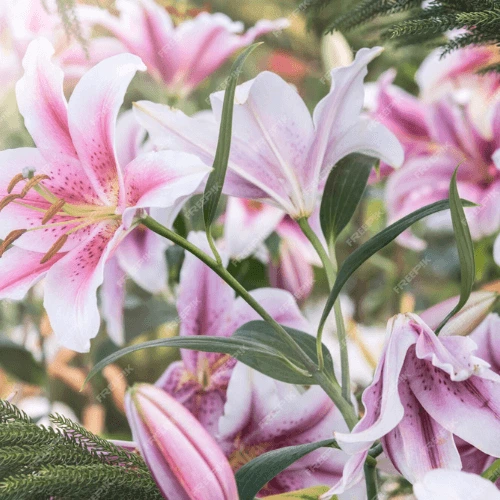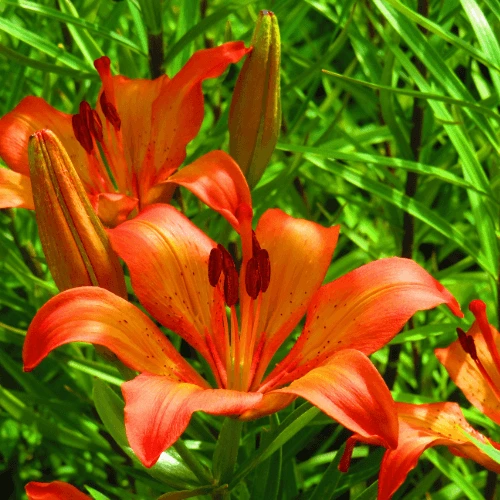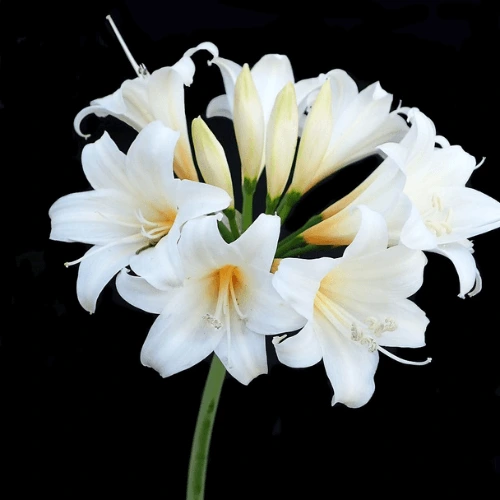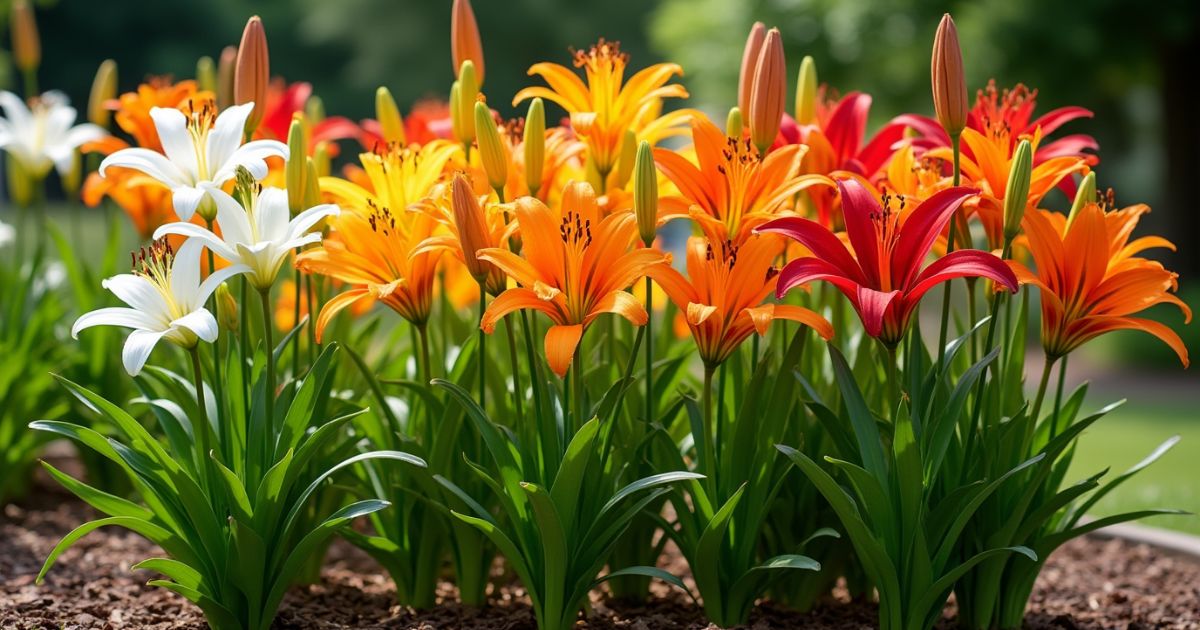In This Article
Asiatic lilies are a gardener’s dream—vibrant, hardy, and remarkably low-maintenance. Known for their bold colors and cold tolerance, these lilies brighten gardens from spring through summer without much fuss. Dive in to discover how these stunning blooms can thrive with just a few simple care steps.
Asiatic Lily Basics
If you’re looking to brighten your garden with low-maintenance yet vibrant flowers, Asiatic lilies are a great choice. Known for their large, colorful blooms, they bring a striking look to any garden. Unlike some lily varieties, Asiatic lilies bloom early in the season, usually in late spring or early summer. They’re also one of the easiest types of lilies to care for, making them perfect for beginners and seasoned gardeners alike.
Asiatic Lily Care Basics
When it comes to Asiatic lily care, location is key. These lilies thrive best in areas with full sun, though they can handle a bit of shade, especially in hotter climates. Aim for 6–8 hours of direct sunlight per day to support strong, healthy growth. Soil is another important factor—choose a spot with well-draining, slightly acidic soil to keep your lilies happy and prevent root rot.
Characteristics to Know
Asiatic lilies are smaller in size compared to other lily types, typically reaching 2 to 4 feet in height. They’re highly adaptable and grow well across USDA zones 4-9, tolerating colder winters with ease. Their blooms come in a wide range of colors, from pure white to vibrant reds, oranges, and yellows. Plus, unlike other lilies, Asiatic lilies have no scent, making them ideal if you prefer a fragrance-free garden.
With just a bit of attention to these basics, you’ll be well on your way to successful Asiatic lily care.



Choosing the Right Location
Choosing the right spot is essential for successful Asiatic lily care. These lilies need the right mix of sunlight, soil, and space to grow strong and produce beautiful blooms. For best results, pick a location where your lilies can receive plenty of sunlight—ideally 6 to 8 hours a day. Asiatic lilies love full sun, but in very hot climates, a little afternoon shade can help prevent wilting or sunburn on leaves.
Soil Requirements
Healthy soil is another crucial part of Asiatic lily care. These lilies prefer well-draining soil with a slightly acidic pH, between 6.0 and 6.5. If you’re unsure about your soil’s pH, you can test it with a simple at-home soil test kit. To improve drainage, consider adding organic matter like compost or sand to the planting area, especially if you have heavy clay soil. Proper drainage prevents water from pooling around the roots, which helps avoid root rot and fungal issues.
Spacing Matters
Space each lily bulb about 8 to 12 inches apart to allow enough room for growth. Proper spacing allows for good air circulation, which keeps plants healthier and reduces the risk of diseases. Plus, with room to grow, your lilies will have space to multiply over the years, creating an even more vibrant display.
Following these simple guidelines for location and spacing can make a big difference in your Asiatic lilies’ growth, helping them thrive season after season.
Planting Asiatic Lilies
Planting correctly is a big step in effective Asiatic lily care. By choosing the right time and following a few basic steps, you’ll set up your lilies for strong growth and healthy blooms.
When to Plant
For best results, plant Asiatic lily bulbs in early spring or fall. Planting in spring allows them to settle in before the summer growing season. If you’re planting in fall, aim for at least four weeks before the ground freezes, giving the bulbs time to establish roots.
How to Plant Asiatic Lily Bulbs
To begin, choose a spot with well-draining soil and plenty of sunlight. Create holes approximately 6 to 8 inches deep. This depth gives the bulbs a solid foundation, protecting them from temperature swings and helping them grow upright. Position each bulb with the pointed end facing upward, then cover it with soil. Pat the soil down gently, but don’t press too hard—loose soil encourages easier root growth.
Spacing and Arrangement
For best results, space your bulbs about 8 to 12 inches apart. This not only ensures each plant has room to grow but also improves airflow around your lilies, helping to prevent disease. For a fuller look in your garden bed, consider planting bulbs in groups of three or five. Asiatic lilies look stunning in clusters and will make a strong visual impact when they bloom.
Watering After Planting
Once planted, give the bulbs a deep watering to help them establish in the soil. Be careful not to overwater—wet soil can lead to root rot. In general, Asiatic lilies prefer moist but not soggy soil, so water only when the top inch feels dry.
Following these steps will help your Asiatic lilies establish a strong start, setting them up for a successful blooming season and making your Asiatic lily care routine simpler.
Watering and Feeding Asiatic Lilies
Proper watering and feeding are key steps in successful Asiatic lily care. By giving your lilies just the right amount of moisture and nutrients, you’ll encourage stronger growth and more vibrant blooms.
Watering Asiatic Lilies
Asiatic lilies need consistent moisture but not soggy soil. After planting, water them deeply to help the bulbs establish strong roots. During the growing season, check the soil regularly. A good guideline is to water when the top inch of soil feels dry to the touch. Aim to keep the soil evenly moist, especially during dry spells, but avoid overwatering, which can cause root rot. In hotter months, a layer of mulch around the base of each plant can help retain moisture and reduce watering needs.
Feeding Asiatic Lilies
Feeding is another important part of Asiatic lily care. Use a balanced, slow-release fertilizer in early spring as soon as you see new growth. A 10-10-10 formula works well, giving your lilies equal parts nitrogen, phosphorus, and potassium. This blend supports healthy leaves, strong stems, and plentiful blooms. You can reapply fertilizer lightly halfway through the growing season to encourage extended flowering.
Avoiding Common Mistakes
Be careful not to over-fertilize, as this can result in abundant foliage but fewer flowers. Also, steer clear of high-nitrogen fertilizers, which can encourage excessive leaf growth instead of flowers.
With the right balance of water and nutrients, your Asiatic lilies will thrive, producing beautiful, healthy blooms that will brighten your garden all season long.
Common Asiatic Lily Pests and Diseases
Keeping pests and diseases under control is a vital part of Asiatic lily care. By spotting issues early and knowing how to manage them, you’ll help your lilies stay healthy and bloom beautifully.
Common Pests
Asiatic lilies can attract pests like aphids and lily beetles. Aphids are small, soft-bodied insects that cluster on stems and leaves, sucking sap and weakening plants. If you see them, spray your lilies with a gentle stream of water to knock them off or use insecticidal soap for larger infestations. Lily beetles are red, hard-shelled insects that chew through leaves, buds, and stems. Hand-picking these beetles early in the season can help prevent damage. You can also try neem oil, an organic pest control option that’s safe and effective.
Preventing Diseases
Asiatic lilies are generally hardy, but they can develop fungal diseases like botrytis blight, which appears as brown spots on leaves and stems. To prevent fungal issues, make sure your lilies have good air circulation by spacing them properly and removing dead leaves around the base of the plant. Water at the soil level instead of overhead to keep leaves dry, as wet leaves can promote fungal growth.
Quick Tips for Disease Control
Inspect your plants regularly to catch problems early, and remove any affected leaves or stems. By staying proactive, you’ll make Asiatic lily care easier and ensure your plants remain vibrant and healthy throughout the season.
Pruning and Deadheading
Pruning and deadheading are simple but essential steps in Asiatic lily care. These practices not only keep your plants looking neat but also encourage healthier growth and better blooms in the future.
Pruning Basics
When your Asiatic lilies finish blooming, you’ll notice that the petals start to wilt and fade. At this point, you can begin pruning. Remove any spent flowers, cutting them down to where the flower stem meets the main stalk. This helps the plant conserve energy and keeps your garden looking tidy. However, avoid cutting the leaves or main stems immediately after flowering, as they’re still gathering energy from sunlight to fuel next year’s growth.
Deadheading for More Blooms
Deadheading, or removing faded blooms, is a key part of Asiatic lily care. By removing the old flowers, you prevent the plant from diverting energy into producing seeds. This energy is then redirected into the bulb, which promotes stronger growth and often leads to more blooms the following season. To deadhead, simply snip off each faded flower, leaving as much of the stem and foliage intact as possible.
End-of-Season Pruning
At the end of the growing season, after the leaves and stems have turned yellow and died back naturally, you can perform a final pruning. Cut the stems down to ground level once they’re fully brown. This helps clear up your garden bed, reducing the chance of pests or diseases overwintering in the foliage. Make sure to dispose of any plant debris, especially if your lilies had any signs of disease.
Additional Tips
To make Asiatic lily care easier, consider mulching around the base of the plants. Mulch helps retain moisture, reduces weeds, and keeps the bulbs at a stable temperature. Following these pruning and deadheading steps will support your lilies’ health, encouraging beautiful blooms year after year.
Winter Care for Asiatic Lilies
As winter approaches, providing the right protection is a crucial part of Asiatic lily care. With the right steps, you can help your lilies survive cold temperatures and emerge healthy in spring.
Preparing for Winter
Asiatic lilies are hardy and can generally withstand winter in USDA zones 4-9. However, they still benefit from a little extra protection as temperatures drop. After the first frost, allow the foliage to die back naturally, which signals the plant to store energy for the next growing season. Once the leaves have fully turned yellow or brown, trim the stems down to ground level.
Mulching for Extra Insulation
Applying a layer of mulch over your Asiatic lilies can help insulate the soil, protecting the bulbs from temperature fluctuations. Spread a 2–3 inch layer of mulch (like straw, shredded leaves, or bark) over the planting area. This layer traps warmth in the soil and helps prevent the bulbs from freezing. In areas with mild winters, mulch may not be necessary, but it’s still helpful for retaining moisture and keeping weeds down.
Indoor Storage for Harsh Winters
If you live in an area with extremely harsh winters or if your lilies are in containers, consider digging up the bulbs and storing them indoors. Gently lift the bulbs from the soil before the ground freezes. Brush off any dirt, let them dry for a few days, and store them in a cool, dry place like a garage or basement. Place them in a breathable container with peat moss or sawdust to keep moisture levels stable.
What to Avoid
Avoid watering your lilies after the ground freezes, as the roots aren’t actively taking in moisture. Overly wet soil in winter can lead to rot.
By taking these steps, your Asiatic lilies will be well-protected through winter, ensuring they’re ready to thrive and bloom again in spring. Winter care is an easy but important part of Asiatic lily care, helping you enjoy healthier, more resilient plants year after year.
FAQs About Asiatic Lily Care
To help you with common questions, here are quick answers to the most frequently asked questions about Asiatic lily care.
1. Can Asiatic Lilies Be Grown in Pots?
Yes, Asiatic lilies grow well in pots if you have limited garden space. Choose a large container with good drainage holes to prevent water buildup. Use a high-quality potting mix, and ensure the pot is at least 10 inches deep to allow root growth. Place the pot in a sunny spot, and water only when the top inch of soil is dry. Container lilies may need winter protection, so consider moving them indoors if temperatures drop too low.
2. How Long Do Asiatic Lilies Bloom?
Asiatic lilies generally bloom in late spring to early summer, and each bloom lasts about 1 to 2 weeks. With proper care, they can continue flowering for several weeks. Deadheading spent blooms also encourages more flowers in the following season by redirecting the plant’s energy.
3. Are Asiatic Lilies Toxic to Pets?
Yes, Asiatic lilies are toxic to cats and can be harmful to dogs. If you have pets that might chew on plants, consider placing lilies out of reach or choosing pet-safe plants. If a pet ingests part of the plant, contact a veterinarian immediately.
4. How Do I Keep My Asiatic Lilies Blooming Year After Year?
For repeat blooms, focus on regular care: give them full sunlight, well-draining soil, and proper feeding. Deadhead and prune carefully, and protect the bulbs during winter. Each year, these practices help the bulbs store more energy, producing beautiful flowers again in spring.
5. Can I Cut Asiatic Lilies for Bouquets?
Yes, Asiatic lilies make excellent cut flowers. When cutting, leave at least one-third of the stem with leaves attached, as the leaves support bulb health and next year’s growth.
These tips will simplify your Asiatic lily care, helping you enjoy these vibrant flowers season after season.
Conclusion
With the right care, Asiatic lilies will reward you with a stunning display that returns year after year. By following these care tips—from planting to winter prep—you’ll keep your lilies healthy and blooming beautifully. If you’re passionate about easy gardening insights, subscribe to our newsletter for a blend of expert advice, crafted to help your garden flourish!

